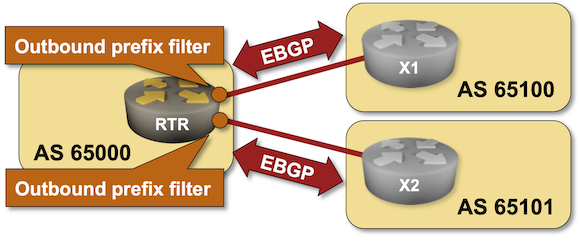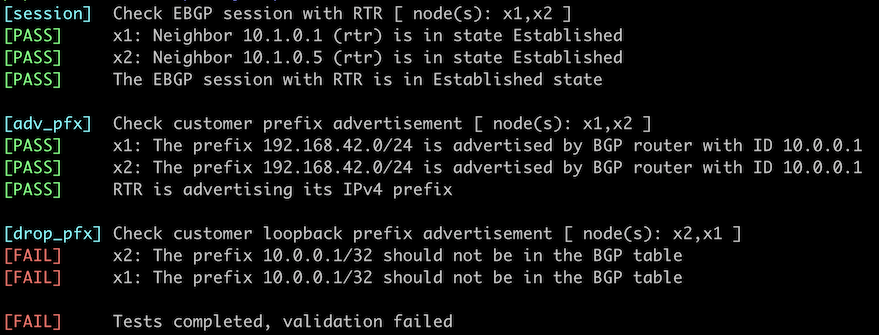Filter Advertised Prefixes
In the previous lab exercise, you filtered prefixes advertised by your router based on the AS-path contents. That’s the absolute minimum you should do, but it’s not always enough. Every other blue moon, a network operator manages to mess up two-way redistribution and advertises hundreds of thousands of prefixes as belonging to their autonomous system. You should, therefore, filter the prefixes advertised to EBGP neighbors to ensure you advertise only the address space assigned to you.
In our simple lab topology, your device advertises a /24 prefix (that we’ll assume is assigned to you) and a loopback (/32) prefix that should not be visible elsewhere.

You don’t have to trust me – after starting the lab, execute the netlab connect --show ip bgp 65000$ command (more details) or an equivalent command for the device you use as the external router. You’ll see that your autonomous system advertises two prefixes; this is what I got in my lab:
BGP table version is 6, local router ID is 10.0.0.10, vrf id 0
Default local pref 100, local AS 65100
Status codes: s suppressed, d damped, h history, * valid, > best, = multipath,
i internal, r RIB-failure, S Stale, R Removed
Nexthop codes: @NNN nexthop's vrf id, < announce-nh-self
Origin codes: i - IGP, e - EGP, ? - incomplete
Network Next Hop Metric LocPrf Weight Path
* 10.0.0.1/32 10.1.0.10 0 65101 65000 i
*> 10.1.0.1 0 65000 i
* 192.168.42.0/24 10.1.0.10 0 65101 65000 ?
*> 10.1.0.1 0 65000 ?
Tip
You could also use a command similar to show ip bgp show ip bgp neighbors neighbor-ip advertised-routes if it’s available on your device to check what you’re advertising to an individual neighbor.
Existing BGP Configuration
The routers in your lab use the following BGP AS numbers. Each autonomous system advertises one loopback address and another IPv4 prefix. Upstream routers (x1, x2) also advertise the default route to your router (rtr).
| Node/ASN | Router ID | Advertised prefixes |
|---|---|---|
| AS65000 | ||
| rtr | 10.0.0.1 | 192.168.42.0/24 10.0.0.1/32 |
| AS65100 | ||
| x1 | 10.0.0.10 | 192.168.100.0/24 |
| AS65101 | ||
| x2 | 10.0.0.11 | 192.168.101.0/24 |
Your router has these EBGP neighbors. netlab configures them automatically; if you’re using some other lab infrastructure, you’ll have to configure EBGP neighbors and advertised prefixes manually.
| Neighbor | Neighbor IPv4 | Neighbor AS |
|---|---|---|
| x1 | 10.1.0.2 | 65100 |
| x2 | 10.1.0.6 | 65101 |
Start the Lab
Assuming you already set up your lab infrastructure:
- Change directory to
policy/3-prefix - Execute netlab up (device requirements, other options)
- Log into your device (RTR) with netlab connect rtr and verify IP addresses and BGP configuration.
Note: netlab will configure IP addressing, EBGP sessions, and BGP prefix advertisements on your router. If you’re not using netlab, continue with the configuration you made during the previous exercise.
Configuration Tasks
You must filter BGP prefixes sent to X1 and X2 and advertise only the 192.168.42.0/24 prefix. Most BGP implementations support prefix lists that match IP prefixes and subnet masks; you should match both to ensure you’re not advertising more specific prefixes to your EBGP neighbors.
On some BGP implementations (for example, Cisco IOS and IOS XE, Cumulus Linux, FRR, Arista EOS), you can apply a prefix list as an inbound or outbound filter on a BGP neighbor.
Some other implementations (for example, Arista EOS) might require a more convoluted approach using a route map as an intermediate step:
- After configuring the prefix list, create a route map that permits BGP prefixes matching your prefix list.
- Apply that route map as an outbound filter to all EBGP neighbors.
Warning
Applying filters to BGP neighbors doesn’t necessarily trigger new updates – you might have to use a command similar to clear ip bgp * soft out to tell your router to recalculate and resend BGP prefixes from its BGP table to its neighbors.
Verification
You can use the netlab validate command if you’ve installed netlab release 1.8.3 or later and use Cumulus Linux, FRR, or Arista EOS on X1 and X2. The validation tests check:
- The state of the EBGP session between RTR and X1/X2.
- Whether RTR advertises the expected IPv4 prefix (192.168.42.0/24).
- Whether RTR advertises its loopback IPv4 prefix (it should not). This is the printout you could get when trying to validate an incomplete solution:

You can also examine the BGP table on X1 and X2 to verify that your router advertises only a single IPv4 prefix. This is the printout you should get on X1:
$ netlab connect --show ip bgp neighbor 10.1.0.1 routes
BGP table version is 8, local router ID is 10.0.0.10, vrf id 0
Default local pref 100, local AS 65100
Status codes: s suppressed, d damped, h history, * valid, > best, = multipath,
i internal, r RIB-failure, S Stale, R Removed
Nexthop codes: @NNN nexthop's vrf id, < announce-nh-self
Origin codes: i - IGP, e - EGP, ? - incomplete
Network Next Hop Metric LocPrf Weight Path
*> 192.168.42.0/24 10.1.0.1 0 65000 ?
You can also check routes advertised to a neighbor on your device if it supports a command similar to show ip bgp show ip bgp neighbors neighbor-ip advertised-routes. This is how the printout looks on Arista EOS:
rtr>show ip bgp neighbors 10.1.0.2 advertised-routes
BGP routing table information for VRF default
Router identifier 10.0.0.1, local AS number 65000
Route status codes: s - suppressed contributor, * - valid, > - active, E - ECMP head, e - ECMP
S - Stale, c - Contributing to ECMP, b - backup, L - labeled-unicast, q - Queued for advertisement
% - Pending BGP convergence
Origin codes: i - IGP, e - EGP, ? - incomplete
RPKI Origin Validation codes: V - valid, I - invalid, U - unknown
AS Path Attributes: Or-ID - Originator ID, C-LST - Cluster List, LL Nexthop - Link Local Nexthop
Network Next Hop Metric AIGP LocPref Weight Path
* > 192.168.42.0/24 10.1.0.1 - - - - 65000 ?
Next: Reduce the size of your BGP table with inbound filters
Reference Information
This lab uses a subset of the 4-router lab topology. The following information might help you if you plan to build custom lab infrastructure:
Device Requirements
- Customer router: use any device supported by the netlab BGP configuration module.
- External routers need support for default route origination and change of BGP local preference. If you want to use an unsupported device as an external router, remove the bgp.originate and bgp.locpref attributes from the lab topology.
- You can do automated lab validation with Arista EOS, Cumulus Linux, or FRR running on external routers. Automated lab validation requires netlab release 1.8.3 or higher.
- You must use Cumulus Linux on the external routers if you’re using netlab release 1.6.3 or older.
- Git repository contains external router initial device configurations for Cumulus Linux.
Lab Wiring
| Origin Device | Origin Port | Destination Device | Destination Port |
|---|---|---|---|
| rtr | Ethernet1 | x1 | swp1 |
| rtr | Ethernet2 | x2 | swp1 |
| x1 | swp2 | x2 | swp2 |
Lab Addressing
| Node/Interface | IPv4 Address | IPv6 Address | Description |
|---|---|---|---|
| rtr | 10.0.0.1/32 | Loopback | |
| Ethernet1 | 10.1.0.1/30 | rtr -> x1 | |
| Ethernet2 | 10.1.0.5/30 | rtr -> x2 | |
| x1 | 192.168.100.1/24 | Loopback | |
| swp1 | 10.1.0.2/30 | x1 -> rtr | |
| swp2 | 10.1.0.9/30 | x1 -> x2 | |
| x2 | 192.168.101.1/24 | Loopback | |
| swp1 | 10.1.0.6/30 | x2 -> rtr | |
| swp2 | 10.1.0.10/30 | x2 -> x1 |